
Steamboat Documents, Page 6
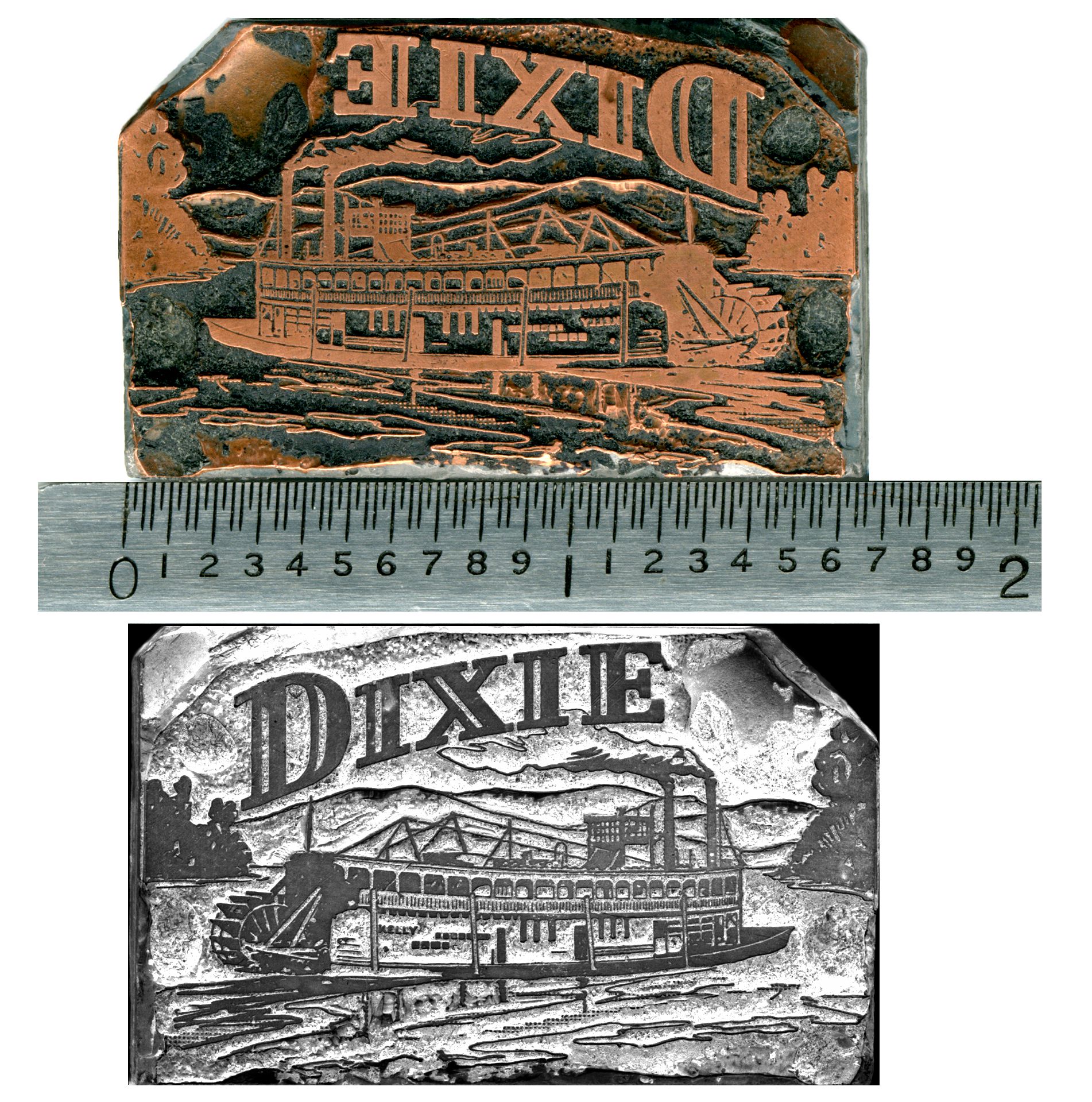
I "PROOFED" THE COPPER PLATED LEAD PRINTER'S BLOCK OF THE LITTLE STEAMER "KELLY" BY MAKING A MIRROR IMAGE OF IT IN PHOTO SHOP, CONVERTED IT TO GRAYSCALE AND ADJUSTED THE CONTRAST. SOMEDAY I'LL FIND A PLACE WITH A LETTERPRESS AND HAVE THEM MAKE A PROOF FROM THIS IN INK ON PAPER.
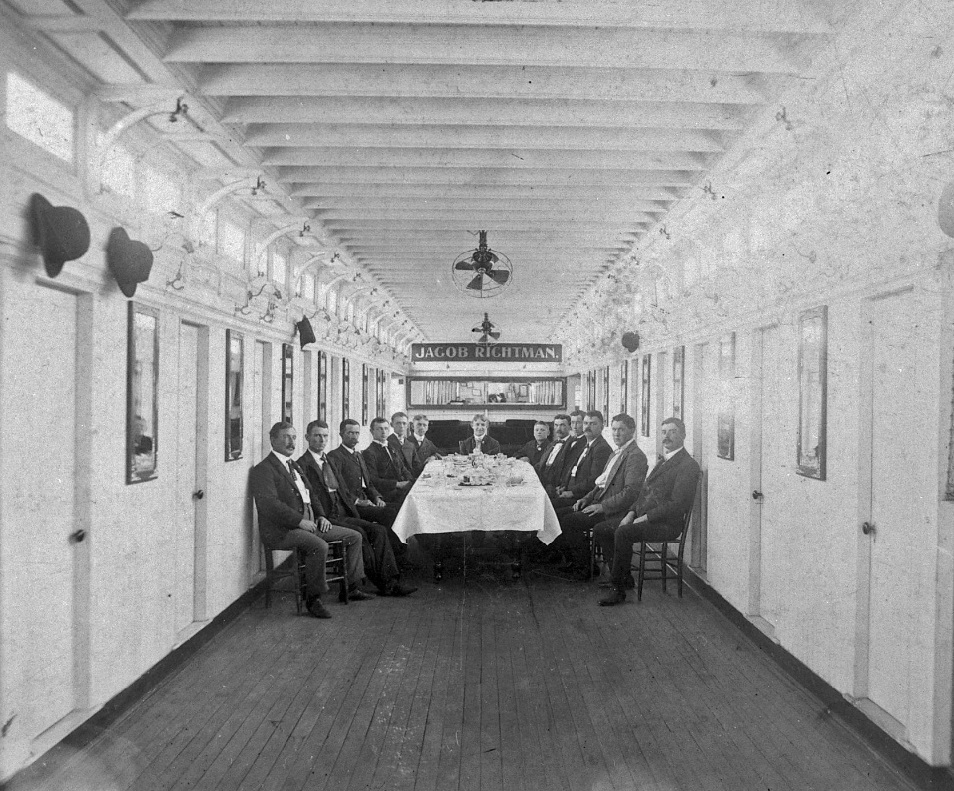
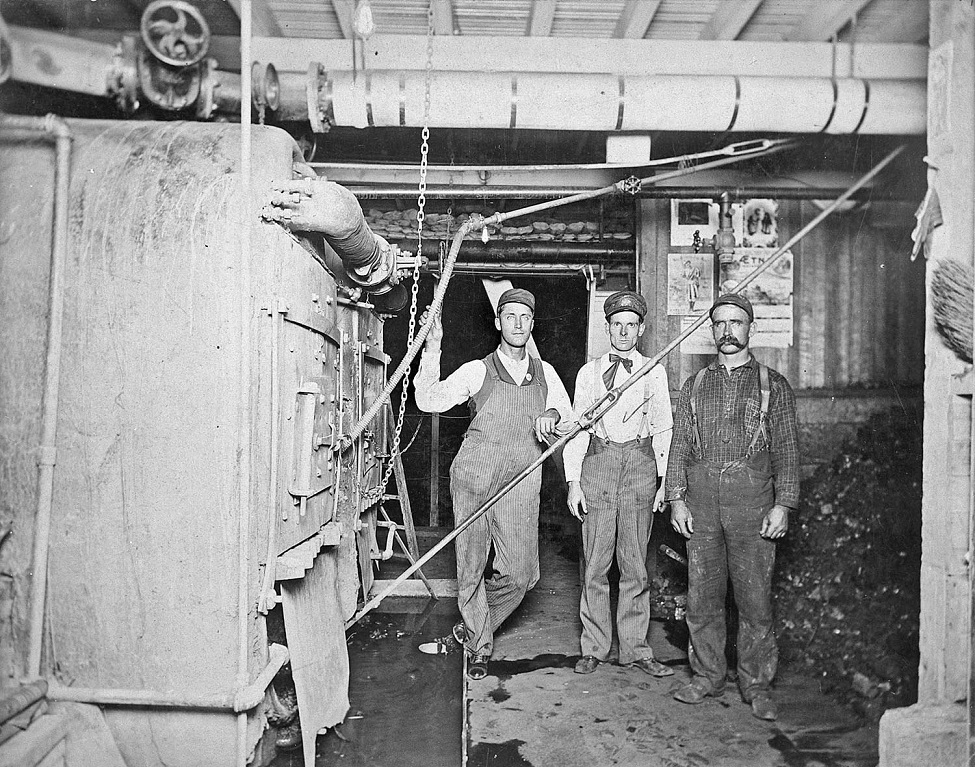
Excursion steamer JACOB RICHTMAN photos of the cabin and the boilers
Photos from La Crosse of the cabin aboard the JACOB RICHTMAN
First: 10 gents plus 2 boys seated around the dining table
Second: Next to the boilers on the RICHTMAN stands the Engineer between two crewmen.
JACOB RICHTMAN
Sternwheel Excursion boat
Way's Packet Directory Number 2913
Built in 1898 at Sterling Island, Illinois
Owned by these 4 members of the Richtman family:
Captains Jacob Senior & Junior and also James and Simon.
Sold to Missouri River and renamed UNCLE SAM in 1904.
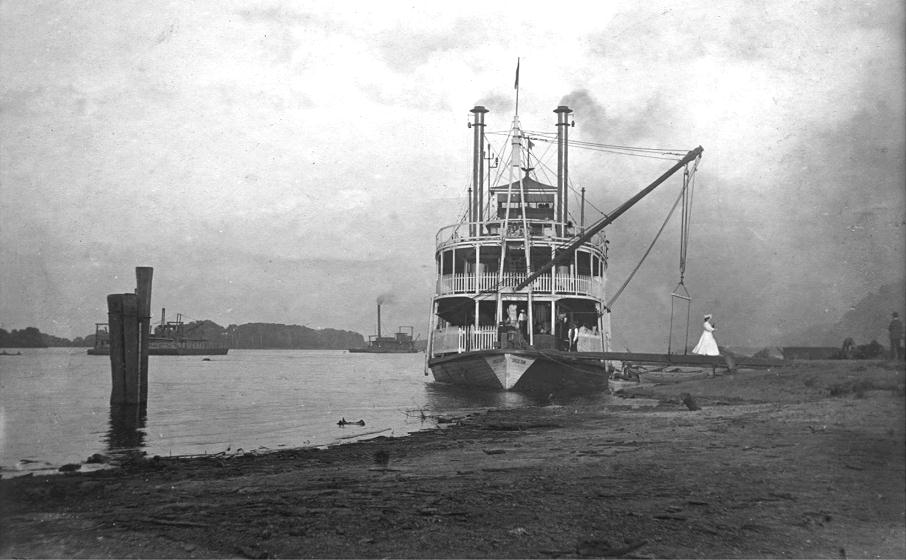
My favorite steamboat photo of the UNCLE SAM from the collection of Hannibal, MO collector Steve Chou. This was taken along the Hannibal waterfront looking south. The lady in white (a bride?) walking ashore on the swinging stage really makes the picture. It's got a sort of Victorian Gothic/Edward Gorey feeling of mystery with a sort of foreboding sky above.
Way's Directory No. 5500 UNCLE SAM
Sternwheeler Sterling Island, Illinois, 1898, originally the excursion steamer JACOB RICHTMAN. Prior to 1904 bought by Clat Adams and his brother of Quincy, Ill.. Burned in Quincy Bay, 1904, having been renamed. Rebuilt and by 1910 was owned by the Missouri River Excursion Co., Capt. E. H. Mattheus, master. While backing away from the landing at Kansas City, Mo., on May 18,1910, she collided with a sand barge and sank after having been run ashore. There were 95 passengers on board but no life loss due largely to John J Pryor, one of the owners who, although he could not swim, stood by and saw all safely ashore.
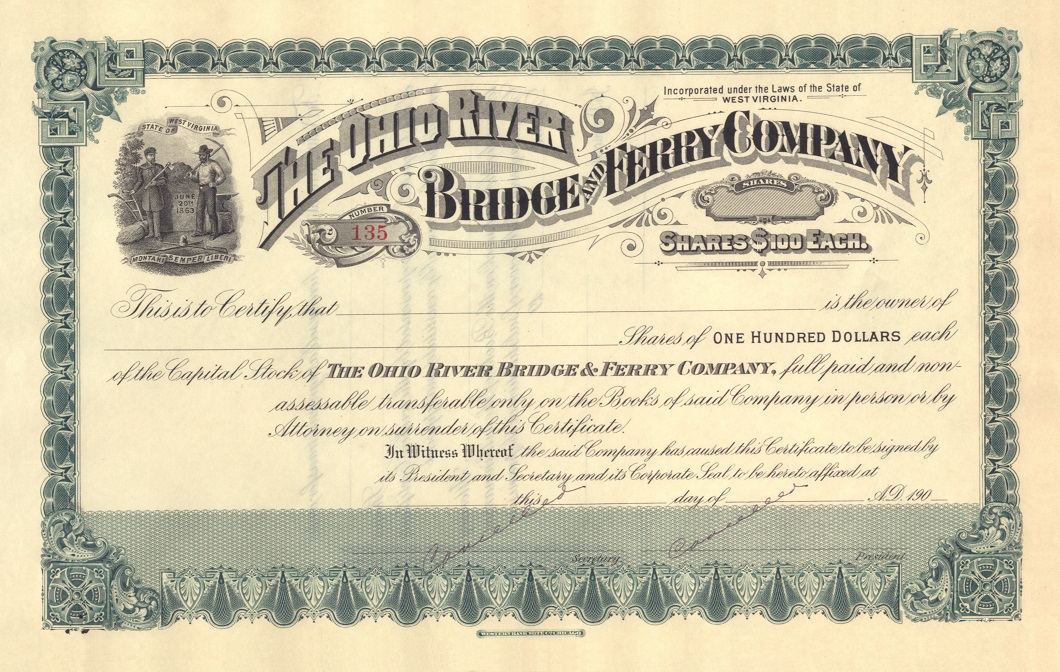
The Ohio River Bridge & Ferry Company
Cancelled Stock Certificate No. 135 for "X" shares at $100 each that was never sold and filled out. Issued by THE OHIO RIVER BRIDGE & FERRY COMPANY - Incorporated under the laws of the State of WEST VIRGINIA. The seal of that state of West Virginia is featured in the upper left corner of the document. This blank form was printed in 1900 when the company was presumably founded but whether or not it actually got up and running is unknown. So far I haven't found reference to this company online or in reference books. Another company or companies that had the same intention to use the ferry and bridge enterprise may have superseded this one.
The company's intention was probably to initially run steam ferries from one side of the Ohio River to the other in different locales within the state of West Virginia while bridges were built within the proximity of the ferry routes. Upon completion of the bridges the ferry service would be discontinued. The company-owned ferries would then travel to the next location where another bridge would be built by the same method. There is probably a treatise on this practice with the history of ferries that were replaced by bridges as was the case in Hannibal, Missouri and a great many other rivertowns.
Augusta, Kentucky is one of the towns on the Ohio River which still maintains ferry service since a bridge was never built there. Crossing the river would have been restricted when ice during the winter made the river impassable or during extreme flooding when the current of the stream became too swift for it to be navigated safely.
wvexp.com
The area of the Ohio River that borders West Virginia, and the islands that located within it, are wholly owned by West Virginia, the deed of cession of the Northwest Territory fixing the low water mark on the Ohio side as the western boundary of (what was then) Virginia. More than 30 West Virginia communities extend along the river.
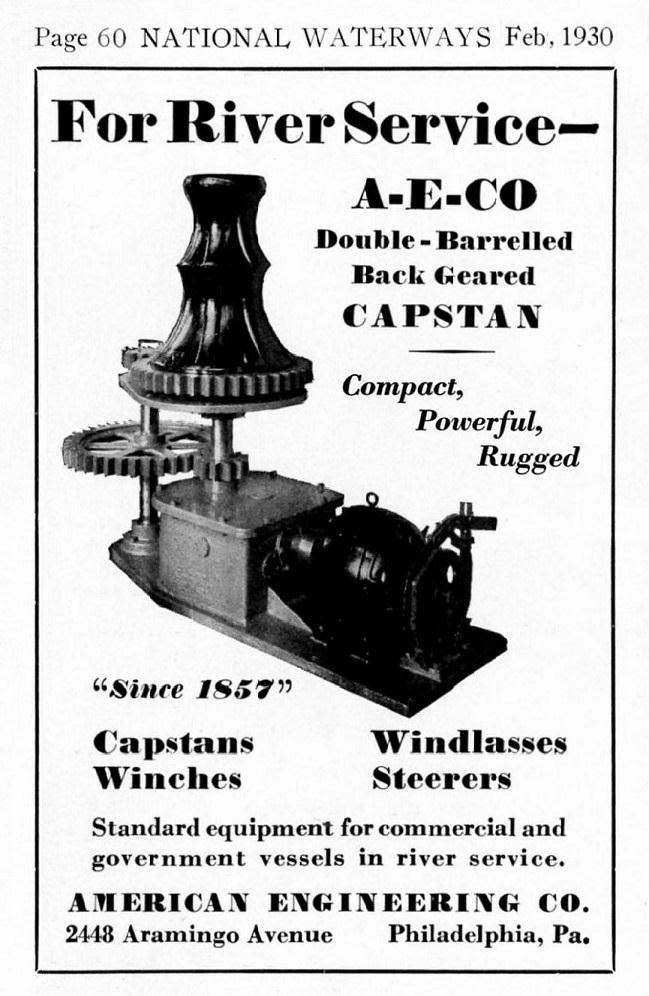
CAPSTANS "For River Services" ad in 1930 Nat'l Waterways
Capstan
Written by The Editors of The Encyclopaedia Britannica
This article was most recently revised and updated by Amy Tikkanen, Corrections Manager
A Capstan is a mechanical device used chiefly on board ships or in shipyards for moving heavy weights by means of ropes, cables, or chains. Capstans also have been used in railroad yards for spotting (positioning) freight cars. A capstan consists of a drum, driven either manually or by steam or electricity, that rotates about a vertical axis to wind in a line (rope, cable, or chain) that has been wrapped around it (see illustration). The grip between the line and the drum depends on friction and on the number of times the line is wrapped around the drum. Speed of drawing in the load can be controlled by allowing partial slippage of the line around the capstan. A notched track (ratchet) on the base plate and pawls attached to the drum prevent backward rotation.
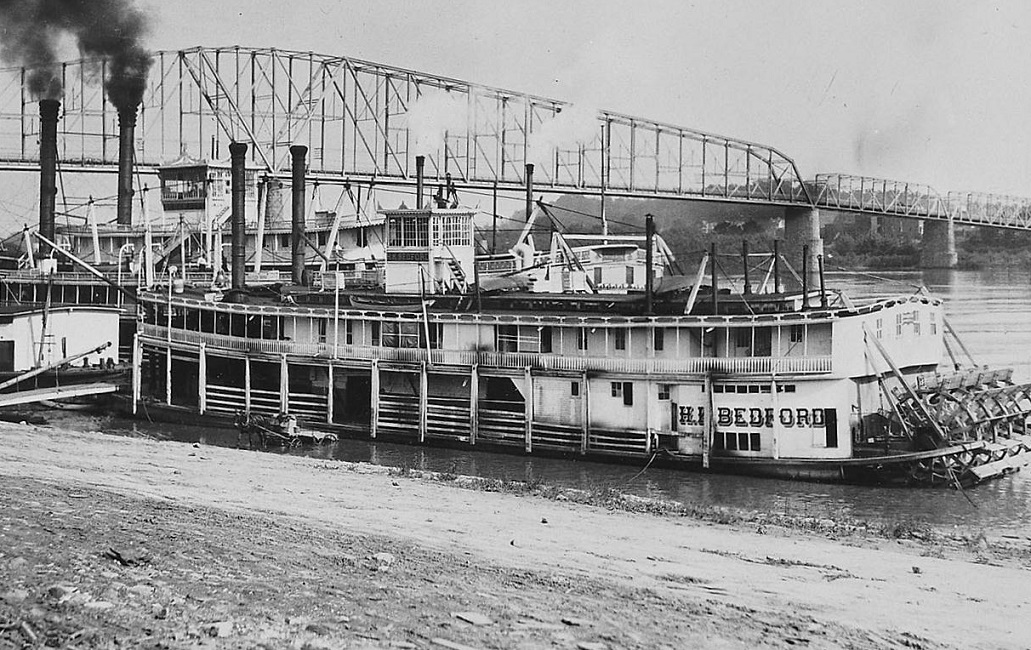
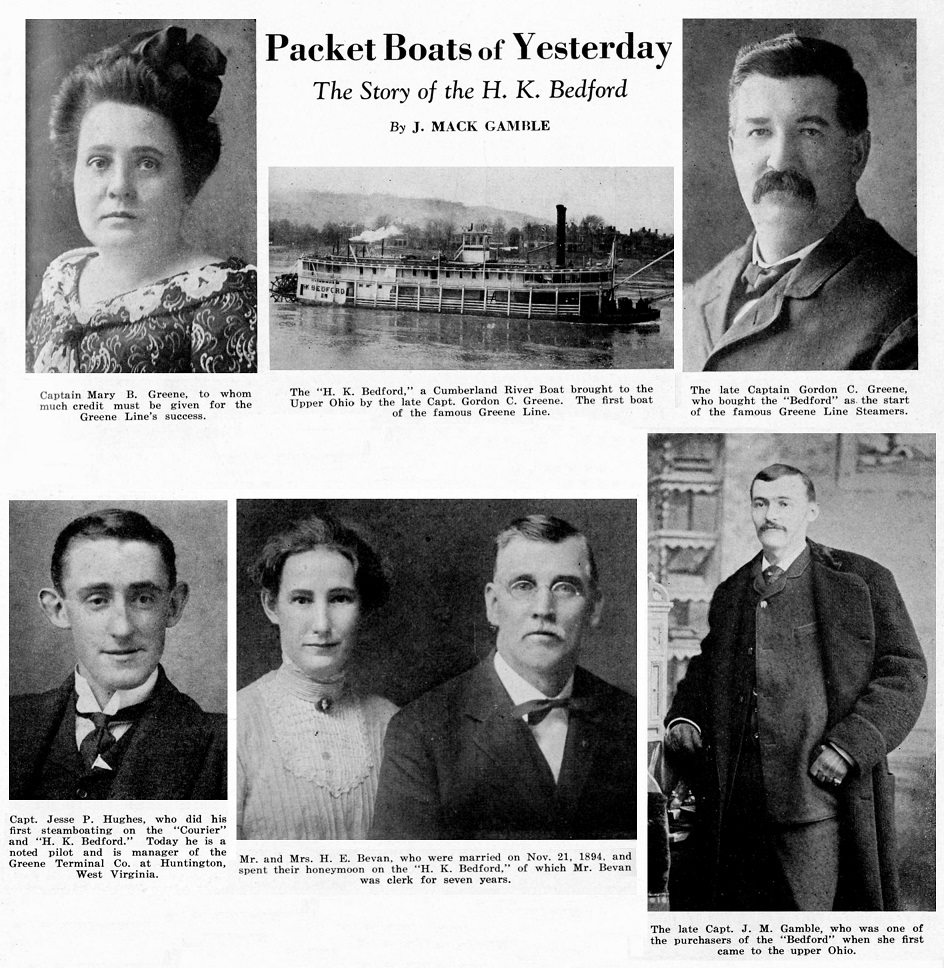
The H.K. Bedford and a montage of six of the photo illustrations from J. Mack Gamble's story on the H.K., Bedford. Pictured here are Captains Mary and Gordon Greene, Captain J. Mack Gamble, Captain Jesse Hughes & Mr. & Mrs. Bevan.
H. K. BEDFORD
Sternwheel Packet (1885-1912)
Way's Packet Directory Number 2491
OWNERS:
Captain Gordon C. Greene (1890); Captain Henry R. Kraft, Charles and C. Augustus Frantz (1898)
OFFICERS & CREW:
Captain A.T. Armstrong (master, 1886); W.W. Parminter (clerk); Captain Gordon C. Greene (master, 1897); Captain Henry R. Kraft (master, 1912); Captain Mary B. Greene (master, 1897); Monroe Greenwood (clerk, 1897); Robert M. McCall (clerk, 1897); J.A. Voegtly (clerk, 1892); Tim Penwell (clerk, 1890); A.J. Slayen (clerk, 1886)
1885 at Jeffersonville, Indiana by Howard Ship Yards. Home port or owner's residence circa 1885, Wheeling, West Virginia.
Original price, $5,600.
Built for the upper Cumberland River. In the fall of 1886, she ran low water trades out of Wheeling, West Virginia. In 1890, after purchase by Captain Greene, she entered the Pittsburgh-Wheeling trade, the beginning of Greene Line Steamers, Incorporated. She later ran Pittsburgh-Charleston. A texas was built on her in 1897 but was removed in 1898. In 1897 she was under charter to the Louisville and Cincinnati Packet Company with Captain Mary B. Greene as master--the first time a woman had been in charge of an L and C packet. After being sold in 1898, she ran Pittsburgh-Parkersburg. On February 3, 1910 she collided with the towboat Little Fred at Pittsburgh, Pennsylvania while backing out of the Monongahela River. Damage to her was $150. On June 12, 1910 she collided with the Sunshine while both were ascending the Ohio River above Freedom, Pennsylvania at the foot of Wallary Bar. The only damage was a portion of the H.K. BEDFORD's guard torn off, value $60. In early 1912, she was laid up by ice at Marietta; she started for Pittsburgh, but was cut down by ice at Bean's Landing, Ohio at Carpenter Bar not far above Marietta, on February 27, 1912. The wreck was removed during low water in 1914.
OFFICERS & CREW:
Captain A.T. Armstrong (master, 1886); W.W. Parminter (clerk); Captain Gordon C. Greene (master, 1897); Captain Henry R. Kraft (master, 1912); Captain Mary B. Greene (master, 1897); Monroe Greenwood (clerk, 1897); Robert M. McCall (clerk, 1897); J.A. Voegtly (clerk, 1892); Tim Penwell (clerk, 1890); A.J. Slayen (clerk, 1886)
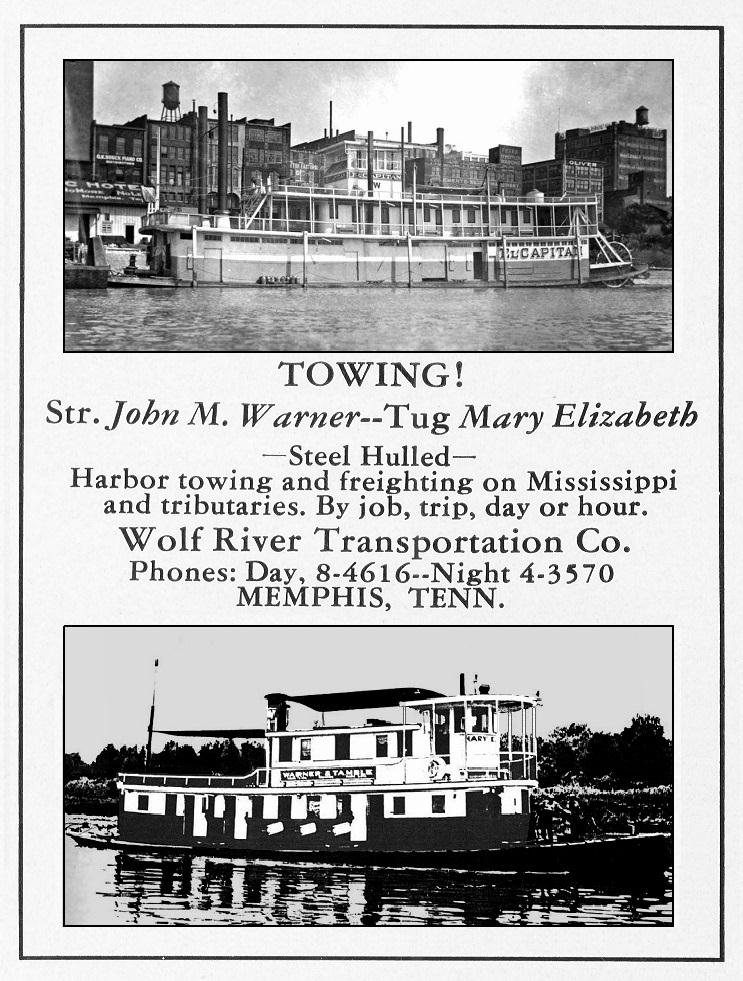
The original "Proud Mary" was the MARY ELIZABETH at Memphis
From the February 1932 NATIONAL WATERWAYS monthly on page 44 an ad for Wolf River Transportation's boats, the towboat JOHN M. WARNER (previously named the EL CAPITAN) and the tug boat MARY ELIZABETH that provided the inspiration for the popular song PROUD MARY.
The photos in the original ad were heavily screened and murky so I replaced them with a La Crosse photo of the EL CAPITAN (that was renamed JOHN M. WARNER when then Wolf River Transportation bought her 2 years prior to this advertisement) and the photo of the MARY ELIZABETH came from Jimmy Ogle's article (below).
JOHN M. WARNER
Sternwheel towboat circa 1930 - 1937
Way's Steam Towboat Directory Number T1420
Originally the EL CAPITAN built in St. Louis in 1903.
109.6 x 26 x 3.5. Engines 12's - 6 1/2 foot stroke.
Renamed when bought by Wolf River Transportaion Co. of Memphis, Tennessee about 1930. They sold her to the Tennessee Valley Authoriy by 1937 and she was then renamed HIWASSEE, later NORMAN CRAWFORD.
PROUD MARY: The story of the MARY ELIZABETH from JIMMY OGLE'S site:
jimmyogle.com
The MARY ELIZABETH was once referred to as the "Queen Mother of Memphis Towboats" for her service in the Memphis Harbor during the middle of the 20th century. Here's how the story unfolds:
The boat that became the inspiration for the "Proud Mary" was built in 1905 for the Lower Hudson Steamboat Company of New York. Originally named the SARAH A. JENKS A. Jenks and later, the OSSINING, she was used to transport convicted prisoners from New York City jails, up the Hudson River to the infamous Sing-Sing State Prison in Ossining, New York - thus explaining the true origin of the expression, "up the river"!
She was moved south in 1911, after being sold to the St. Tammany Steamship Company of Covington, Louisiana. The OSSINING spent the next four years being operated as a Ferry Boat over the 630 square mile Lake Ponchartrain.
In 1915 she was sold to Lyon Bros. of Greenville, Mississippi and used to run U.S. Mail from Greenville, upriver to Luna Landing, Arkansas. During this time, she was also converted from steam power to diesel power, which gave the OSSINING the distinction of being the first diesel power Ferry Boat on the Mississippi River.
After a dozen years, she was sold in 1928 to Warner & Tamble Inc. of Memphis, Tennessee. At this time she was refitted and remodeled into a Tow Boat, and rechristened to it's more familiar name, the MARY ELIZABETH, in honor of a family member of the new Memphis owner.
During her decades of service in Memphis, the MARY ELIZABETH was responsible for numerous duties. When the Harrahan Bridge burned in 1928, blocking all vehicle traffic for months until the roadway could be replaced, it was the Mary Elizabeth that ferried all commerce across the Mississippi River to Arkansas. She also transported over 3,000 head of cattle to river islands during the Dust Bowl era drought of 1934; performed salvage and rescue work during the big flood on the Wolf River in 1935; and worked throughout the area in rescue and levee work during the great flood of 1937. In 1939, she installed the first radio-telephone communication lines along the Wolf River and the Memphis Harbor. At this time, she also became the first Tow Boat on the Mississippi River to be equipped with a ship-to-shore radio.
In 1973, the MARY ELIZABETH was sold to Murphy Marine Service Inc. of Memphis. Murphy Marine ran her for a total of five years and then pulled her out of service.
1979 was to be the hardest year for the MARY ELIZABETH. Sold to a scrap dealer, George Perkins of Memphis, the MARY ELIZABETH was destined to be stripped and gutted. She had the first and second deck mid-ship house (The main superstructure located at the center of the ship.) removed and her engine pulled out. She was then stripped of all equipment, towed away and beached off the Lossahatchie River just above Memphis - only to rust from the merciless beating by the weather over the following seven years.
Hope of resurrection came in 1986 when the MARY ELIZABETH was sold to Proud Mary Restoration Inc. The hope grew as the first signs of restoration were seen in January, 1987. However, it was not to be. In 1988, during the all-time low of the river gage in Memphis (-10.7 in the second week of July), the MARY ELIZABETH began breaking up on the bank of the river and was hauled away for scrap.
During the 1960s, at the height of the Rock 'n' Roll era in Memphis, a deck hand on the MARY ELIZABETH wrote and composed a song he entitled, "Proud Mary" The song describes his feelings and experiences, his life and times aboard his ship, the MARY ELIZABETH. The song was published and recorded by John Fogerty of Creedance Clearwater Revival, and was also performed by other artists such as George Jones and Johnny Paycheck, Elvis Presley, Bruce Springsteen and pop diva, Tina Tuner. Tina Turner's upbeat rendition was more in the early 1980s style of music and entitled "Rollin' On The River". The tune has become one of the most popular and enduring songs of our age and has been placed #155 on Rolling Stone's 2004 list of The 500 Greatest Songs of All Time.
Many people that listen to the lyrics of the song, come away with the impression that the PROUD MARY was a steamboat pushed by sternwheel paddles - those "big wheels keep on turning . . ." Well I'm sorry, but you'd be wrong. In the riverboat vocabulary for tow boats, the word "wheels" often refers to the propellers under the boat that are turned by the engines. Another term is "screws" due to the propellers usually looking like oversized screws and while rotating to propel the vessel, they resemble a screw being turned. So in reality, the "big wheels that keep on turning" are under the tow boat, under water and out of sight, not the big paddlewheels seen behind a steamboat.
In 1993 my old friend, the late Capt. Jake Meanley (1948-2000) told me that in the 1970s when he was piloting ships for the MEMPHIS QUEEN LINE excursion company, he quite often used the MARY ELIZABETH through a lease agreement from Murphy Marine. She was used to push the MEMPHIS SHOWBOAT (barge) on countless moonlight river cruises. We can only guess at how many times that the bands were asked to play "Proud Mary."
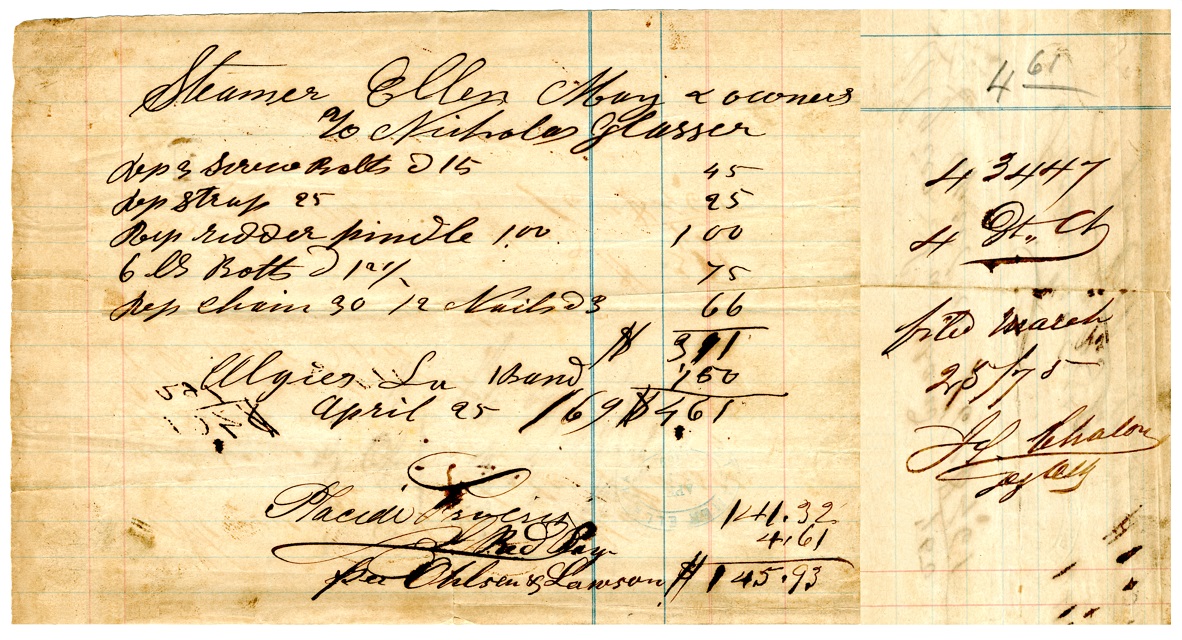
Invoice for repairs to the Steamboat ELLEN MAY 25th of March 1875
The handwriting is difficult to decipher but some of words that are more or less legible are as follows; Steamer Ellen May & owners c/o Nicholas Glasser screw bolts, strap, rudder (s)pindle & chains Algier(s), La (Louisiana) per Ohlsen & Lawson filed March 25/75
document
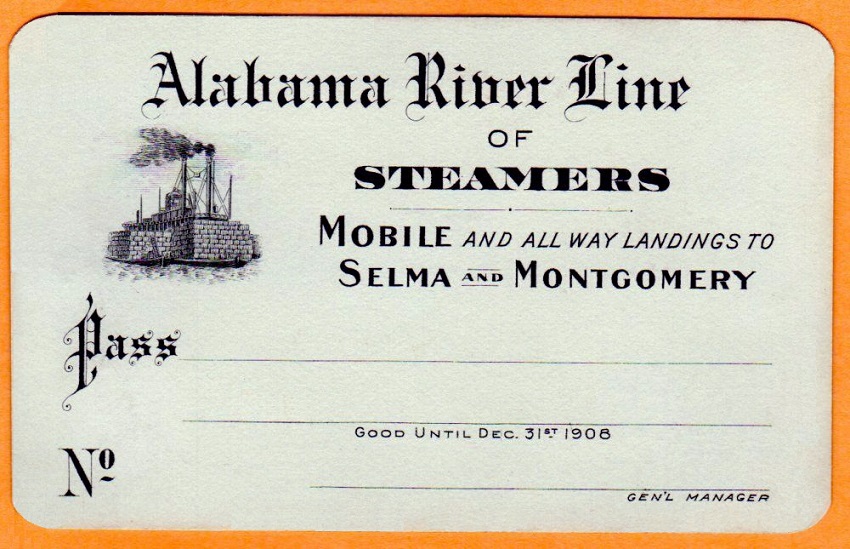
ALABAMA RIVER LINE STEAMERS
1908 Pass for Alabama River Line Steamers
MOBILE & ALL WAY LANDINGS TO SELMA & MONTGOMERY
JIM HALE APPROVED:
"A NICE PASS FOR THE ALABAMA RIVER STEAMBOATS. I AM PRETTY SURE THE BOAT ON THE PASS IS THE NETTIE QUILL BECAUSE OF THE COTTON BALE HUNG BETWEEN THE STACKS. THE HARD CASH HAD ONE TOO. BUT I DON'T THINK THIS IS THE CASH. THANKS FOR SENDING ME A COPY. I WILL ADD IT TO MY ALABAMA COLLECTION."
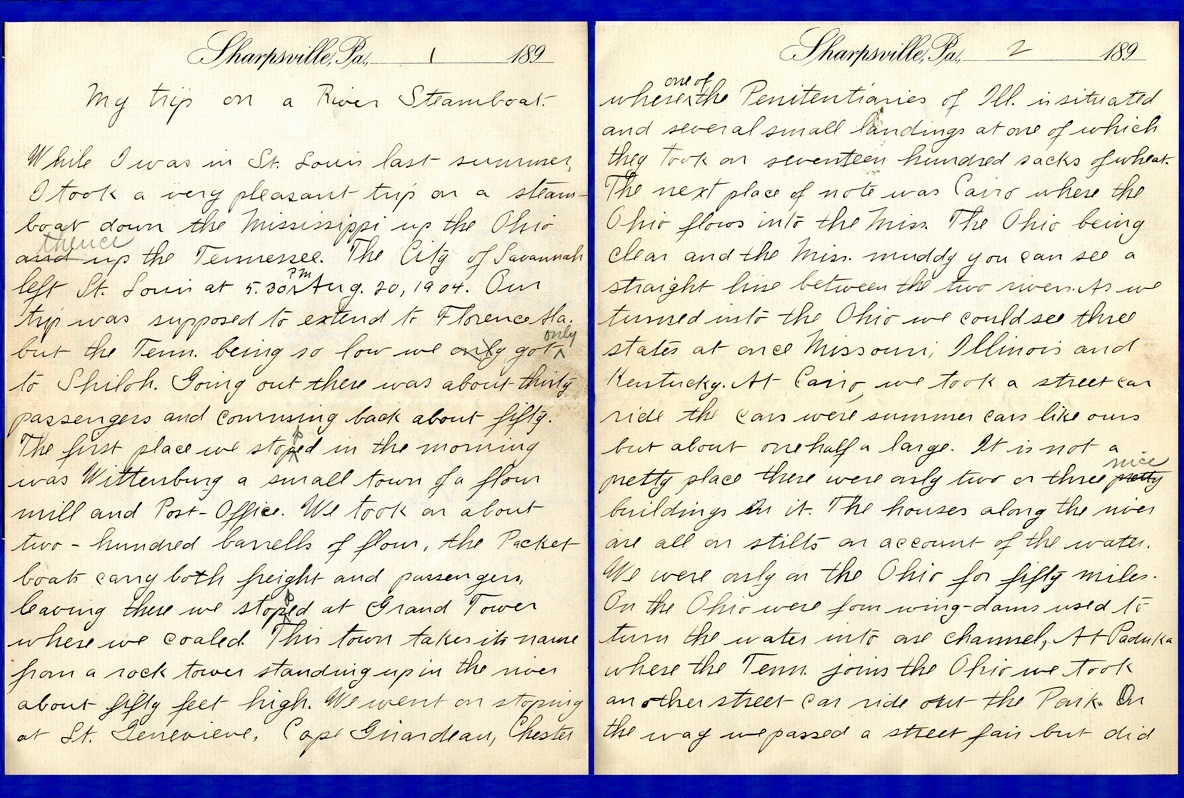
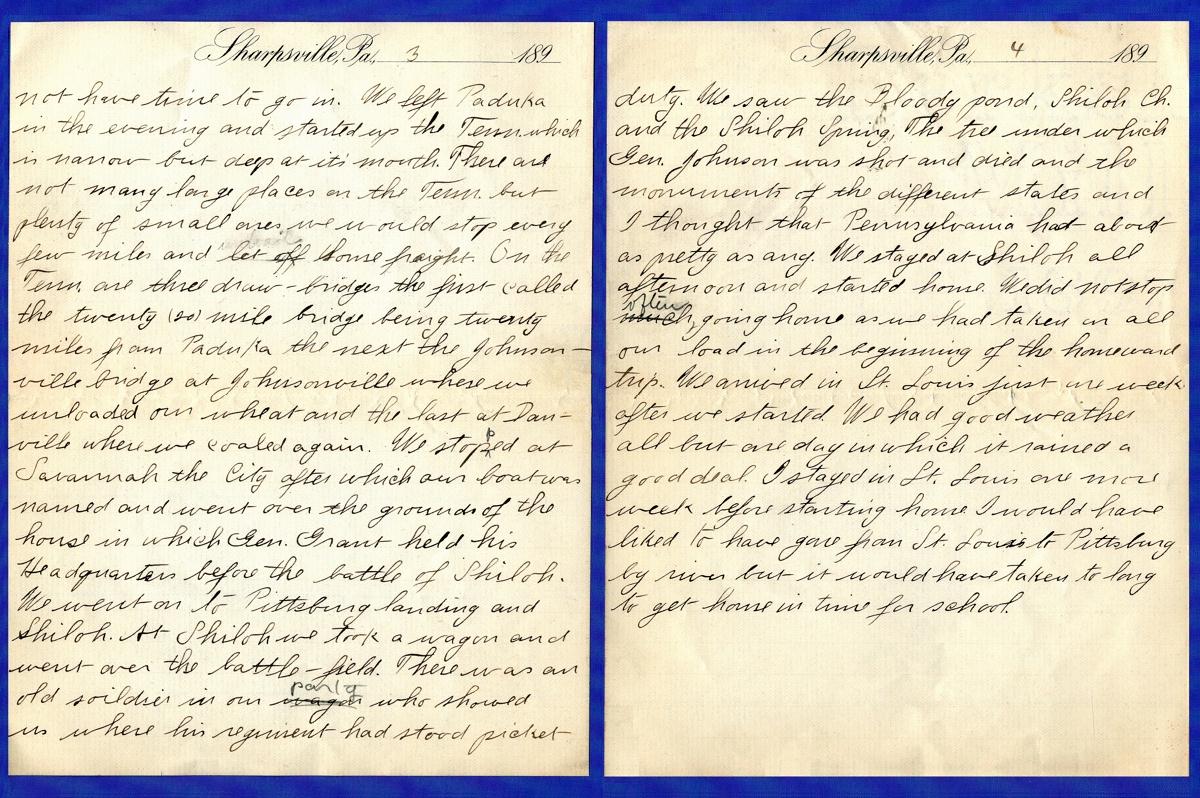
My trip on a River Steamboat. 1904
Transcript of a four page manuscript handwritten on Sharpsville, Pennsylvania stationery by an un-named Pennsylvania schoolboy about his trip on the steamboat CITY OF SAVANNAH commencing at St. Louis, Missouri on August 20th 1904, going down the Mississippi River to the Ohio and then up the Tennessee River to the Civil War battlefield at Shiloh.
My trip on a River Steamboat.
While I was in St. Louis last summer, I took a very pleasant trip on a steamboat down the Mississippi up the Ohio thence up the Tennessee. The CITY OF SAVANNAH left St. Louis at 5:30 PM Aug. 20, 1904. Our trip was supposed to extend to Florence, Alabama but the Tennessee being so low we got only to Shiloh. Going out there was about thirty passengers and coming back about fifty. The first place we stopped in the morning was Wittensburg a small town of a flour mill and Post-Office. We took on about two-hundred barrels of flour, the packet boats carry both freight and passengers, leaving these we stopped at Grand Tower where we coaled. This town takes its name from a rock tower standing up in the river about fifty feet high. We went on stopping at St. Genevieve, Cape Girardeau, Chester where one of the Penitentiaries of Illinois is situated and several small landings at one of which they took on seventeen hundred sacks of wheat. The next place of note was Cairo where the Ohio flow into the Mississippi. The Ohio being clear and the Mississippi muddy you can see a straight line between the two rivers. As we turned in into the Ohio we could see three states at once - Missouri, Illinois and Kentucky. At Cairo we took a street card ride, the cars were Summer cars like ours but about one half as large. It is not a pretty place, there were on two or three nice buildings in it. The houses along the river are all on stilts on account of the water. We were only on the Ohio for fifty miles. On the Ohio were four wing-dams used to turn the water into the channel. At Paducah where the Tennessee joins the Ohio we took another street car ride out to the Park. On the way we passed a street fair but did not have time to go in. We left Paducah in the evening and started up the Tennessee which is narrow but deep at its mouth. There are not many large places on the Tennessee but plenty of small ones. We would stop every few miles and upload some freight. On the Tennessee are three draw-bridges, the first called the twenty (20) mile bridge being twenty miles from Paducah, the next the Johnsonville bridge at Johnsonville where we unloaded our wheat and the last at Danville where we coaled again. We stopped at Savannah, the City after which our boat was named and went over the grounds of the house in which General Grant held his headquarters before the battle of Shiloh. We went on to Pittsburg landing and Shiloh. At Shiloh we took a wagon and went over the battlefield. There was an old soldier in our party who showed us here his regiment had stood picket duty. We saw the Bloody pond, Shiloh Church and the Shiloh Spring, the tree under which General Johnson was shot and died and the monuments of the different states and I thought that Pennsylvania had about as pretty as any. We stayed at Shiloh all afternoon and started home. We did not stop often going home as we had taken on all our load in the beginning of the homeward trip. We arrived in St. Louis just one week after we started. We had good weather all but one day in which it rained a good deal. I stayed in St. Louis one more week before starting home. I would have liked to have gone from St. Louis to Pittsburg by river but it would have taken too long to get home in time for school.
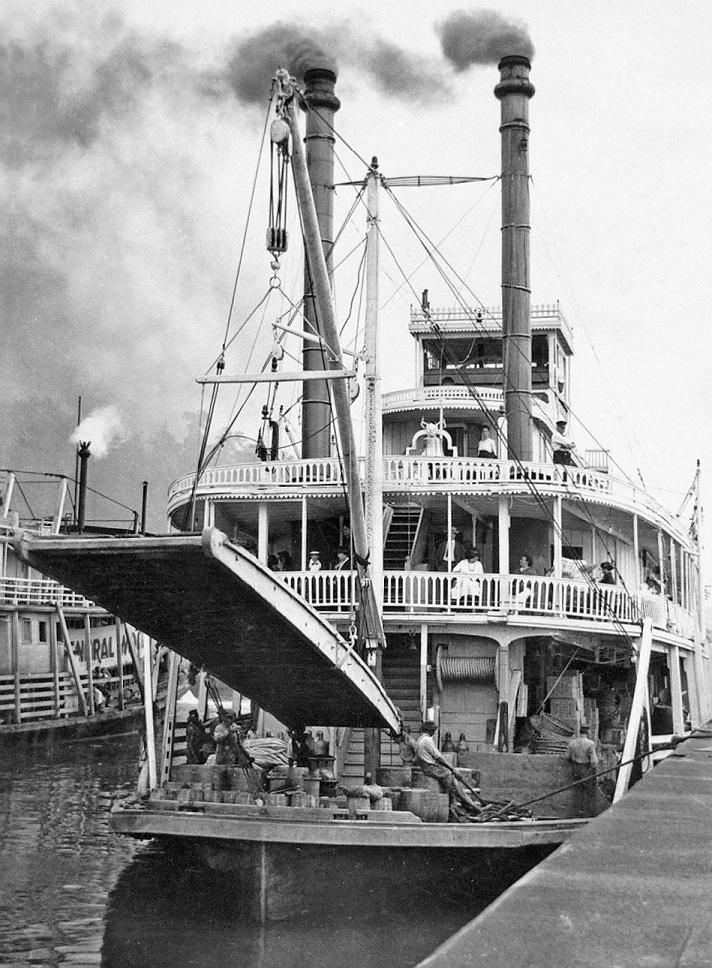
Packet GENERAL WOOD on left, BETSY ANN on right; at Davis Island Lock, Bellevue, Ohio, August 20, 1921.
BETSY ANN (1899-1940)
Sternwheel Packet/Towboat/Excursion boat
Ran on the Ohio and Mississippi rivers
Built by Iowa Iron Works, and the engines by Clinton Novelty Iron Works; whistle from the STELLA WILDS.
The BETSY ANN was first owned by R. F. Learnerd, Natchez, Mississippi, and named for his wife Elizabeth.
She ran principally in the Natchez-Bayou Sara trade and carried the U.S. mail. She was sold in fall of 1921 to D. Grover Gill, Gallipolis, Ohio, and others who ran her Pittsburgh-Portsmouth, then Pittsburgh-Cincinnati, incorporated as Independent Packet Company. Frederick Way and Frederick Way, Jr. bought stock late 1925 and continued running her Pittsburgh-Cincinnati into 1929. She ran Pittsburgh-Louisville summer 1930, then Pittsburgh-Charleston, and finally returned to the Pittsburgh-Cincinnati trade November 3, 1930 through April 25, 1931. She left Pittsburgh November 2, 1931 and went to Memphis under charter to tow cotton. She made one trip to Caruthersville and another to Vicksburg, returning to Memphis December 6, 1931. She was sold to John I. Hay Company, spring 1932, and was put to towing barges. She was dismantled at the St. Louis wharf in fall 1940.
The boat is best remembered for having run three staged races at Cincinnati, on July 24, 1928 with the packet CHRIS GREENE, on July 16, 1929 with the packet TOM GREENE, and again in 1930 with the TOM GREENE. These events led to the "rebirth" of steamboat racing as a popular sport
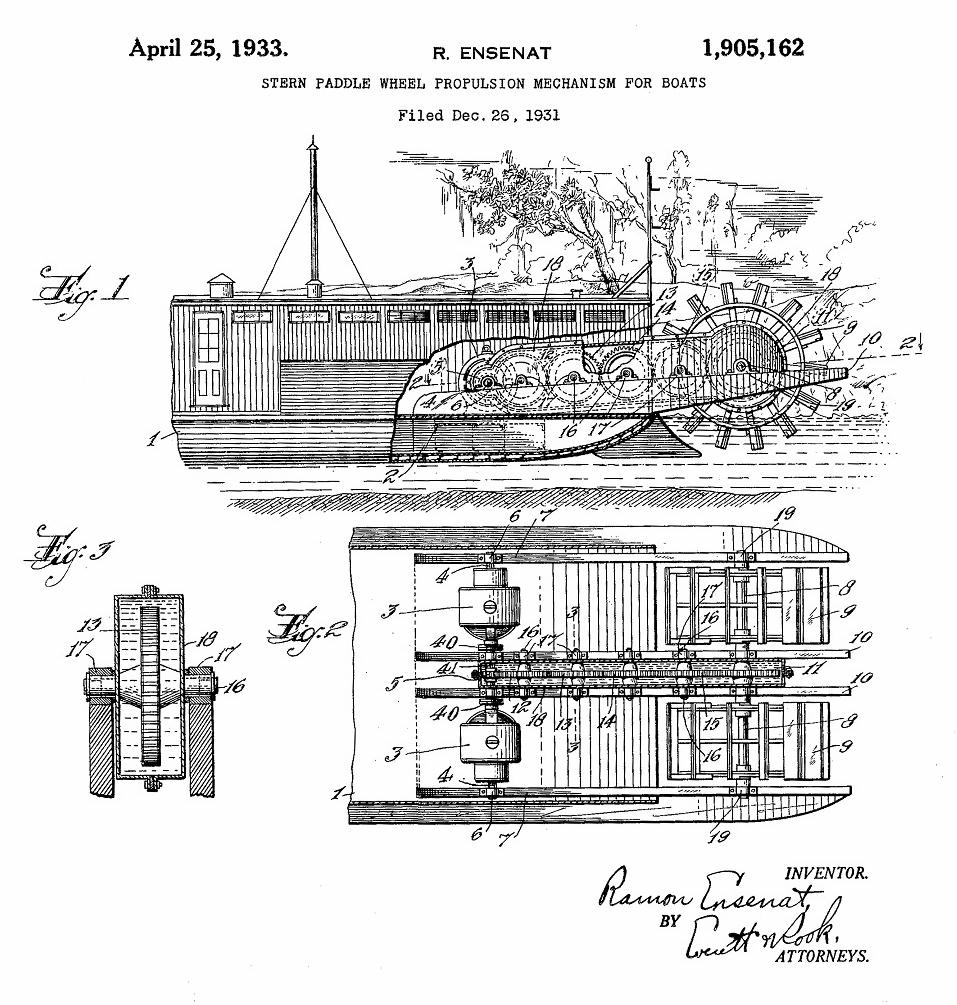
STERN PADDLE WHEEL PROPULSION MECHANISM FOR BOATS
Drawing etc. submitted with application for a patent:
STERN PADDLE WHEEL PROPULSION MECHANISM FOR BOATS
PATENT ORIGINALLY FILED DEC. 26, 1931
APRIL 25 1933 PATENT GRANTED
NUMBER 1,905,162
RAMON ENSENAT & EVERETT ROOK ATTORNEYS
patents.google.com
Arrangements on vessels of propulsion elements directly acting on water of paddle wheels, e.g. of stern wheels
United States
Patent
Inventor Edwin J.C. Joerg
Worldwide applications
1931 US
Application number: US583169A
Filing date: 1931-12-26
Application filed by Edwin J.C. Joerg
1931-12-26
Priority to US583169A
Application granted
1933-04-25

With the exception of images credited to public institutions,
everything on this page is from a private collection.
With the exception of images credited to public institutions,
everything on this page is from a private collection.
Please contact Steamboats.com for permission for commercial use.*
All captions provided by Dave Thomson, Steamboats.com primary contributor and historian.
